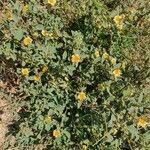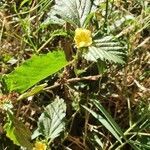Herbs, annual or perennial, 0.2–0.6(–1) m, with 1 main stem, freely branching in proximal 1/2. Stems erect or decumbent, hairs scattered, appressed, bilateral, (2–)4-rayed, swollen-based, not sublepidote, hairs 1–3 mm. Leaves: stipules persistent, lanceolate, subfalcate to falcate, 3–6 × 0.5–1 mm, apex acuminate; petiole 10–20(–40) mm; blade ovate to ± lanceolate, unlobed, (1.7–)3–4(–6.5) × (0.6–)1.5–3(–5.5) cm, 1.1–2.8 times longer than wide, 2.5–4.5 times longer than petiole, not greatly reduced on stem distally, base truncate to broadly-rounded to often wide-cuneate, margins dentate to serrate, apex acute, surfaces sparsely hairy, hairs bilateral, 2–4-rayed, stellate or with simple hairs on adaxial surface. Inflorescences axillary, solitary flowers, flowers sometimes congested towards branch tips; floral bracts absent. Pedicels 1–2 mm, to 3–5 mm in fruit; involucellar bractlets basally adnate to calyx for 0.5–1 mm, lanceolate, subfalcate, 4–6 × 0.6–1 mm, shorter than calyx lobes, apex acute.
Subshrubs, sometimes annual, to 1(-1.5) m tall, most parts pilose and appressed stellate pubescent. Stipules lanceolate, 5-7 mm; petiole 0.7-3 cm, densely pilose; leaf blade ovate-lanceolate or ovate, 3-7 × 0.8-4 cm, abaxially pilose and stellate pilose, adaxially sparsely hairy, base broadly cuneate to rounded, margin coarsely dentate, apex acute or obtuse. Flowers axillary, solitary. Pedicel 3-5(-10) mm, pilose. Epicalyx lobes filiform, ca. 5 × 1 mm, pilose. Calyx shallowly cup-shaped, 5-7 mm in flower, accrescent to 8-11 mm in fruit, lobes ovate, ca. 8 mm, abaxially sparsely pubescent with stellate hairs, adaxially nearly glabrous, apex acuminate. Corolla apricot-yellow, ca. 1.5 cm in diam.; petals obovate, 6-9 × ca. 4 mm. Filament tube ca. 6 mm, glabrous. Schizocarp ca. 6 mm in diam.; mericarps 8-12(-14), reniform, sparsely pubescent with simple hairs mixed with stellate hairs, ca. 2.5 mm in diam., 3-cusped (2 abaxial, 1 apical), endoglossum lacking. Seeds ca. 1 mm in diam.
Erect to spreading, annual or biennial suffrutex, 0.6-1.0 m high; young parts densely covered with simple and 4-rayed, white stellate-strigose hairs. Leaves simple, lanceolate to ovate, dentate; veins of lower surfaces white-strigose. Flowers axillary, solitary or in few-flowered clusters. Epicalyx of 3 linear-lanceolate bracts. Calyx campanulate, foliaceous in fruit. Petals scarcely longer than calyx, pale yellow or yellow-orange. Staminal tube shorter than petals; filaments divided at apex into ± 20-40 anthers. Flowering time Oct.-Feb. Fruit a discoid schizocarp. Mericarps 10-15, 1-seeded, indehiscent, reniform, hispid, with 1 apical and 2 dorsal awns pointing outward. Seeds reniform, glabrous.
A herb or shrub. It keeps growing from year to year. It grows 0.2-1.5 m high. It is hairy. The leaves are 1-7 cm long and 1-4 cm wide. The flowers are yellow or red. The flowers are in the axils and can occur singly or be in groups. The fruit are round and in groups of 8-14 and 2 mm across.
Annual or biennial herb, up to 1 m high, sparsely covered with simple and 4-rayed stellate-strigose hairs. Leaves ovate, coarsely serrate. Flowers yellow.












